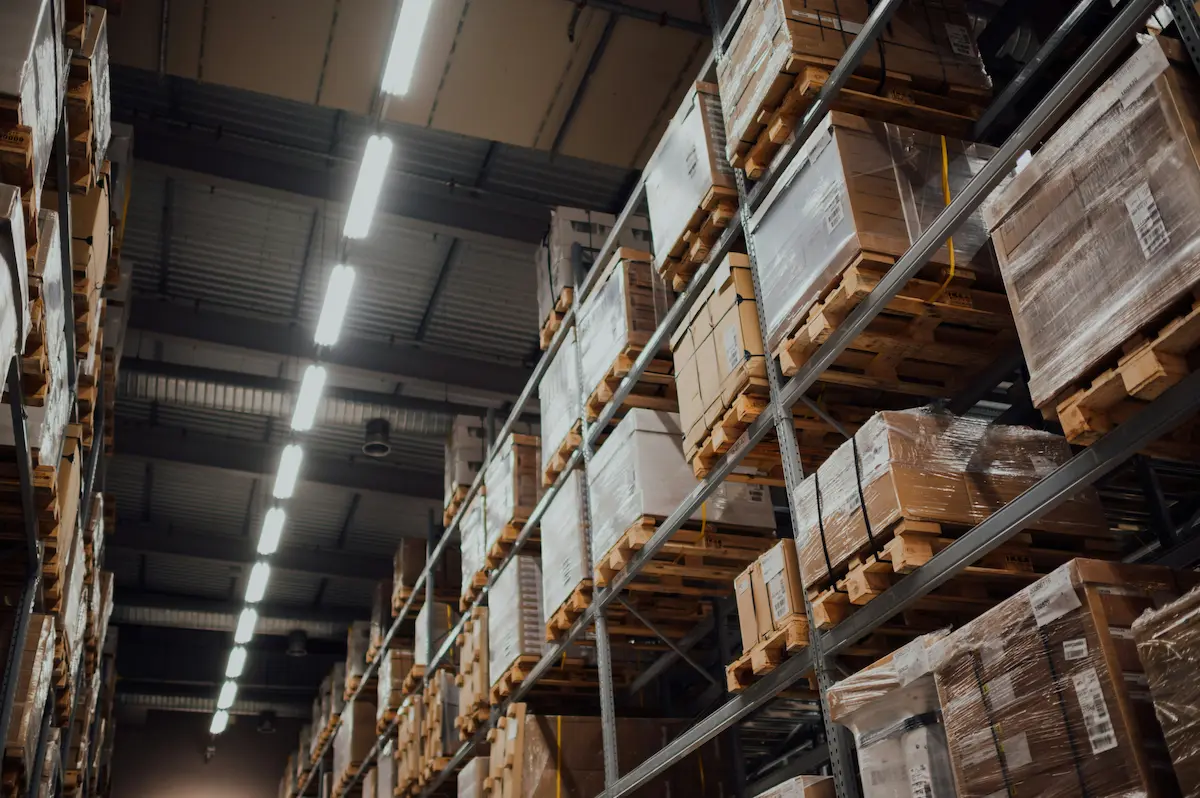
A side-by-side comparison of the best inventory optimisation software
Got no time to read the full article? Here’s the top 5 including their key target audience and free trial options.
The top 5 inventory optimisation software tools
Inventory optimisation software helps businesses decide what to order, how much, and when, to keep just the right amount of stock. Instead of relying on spreadsheets or gut feeling, it uses data and smart algorithms to forecast demand, prevent stock-outs, and avoid excess inventory.
Some tools provide insights and suggestions, while others go a step further by automating the entire purchasing process using real-time data and AI. Now let’s take a look at the best solutions out there. The tools have been selected based on feedback, ratings and features offered.
1. Optiply
Optiply, that’s us, is an AI-powered inventory optimisation platform built for e-commerce, retail, and wholesale businesses that purchase daily and manage large assortments. Unlike traditional tools that provide insights but leave the execution up to you, Optiply fully automates your replenishment process. From demand forecasting to sending purchase orders to your suppliers.
Its biggest strength? 100% automation. Optiply continuously analyses real-time data and external factors (like lead times, pricing changes, or marketing campaigns) to make smart purchasing decisions for you. No more manual checking, tweaking, or second-guessing.
Instead of spending hours reviewing exceptions or updating forecasts, your team can focus on growth, while Optiply ensures you have the right stock, at the right time, every day.
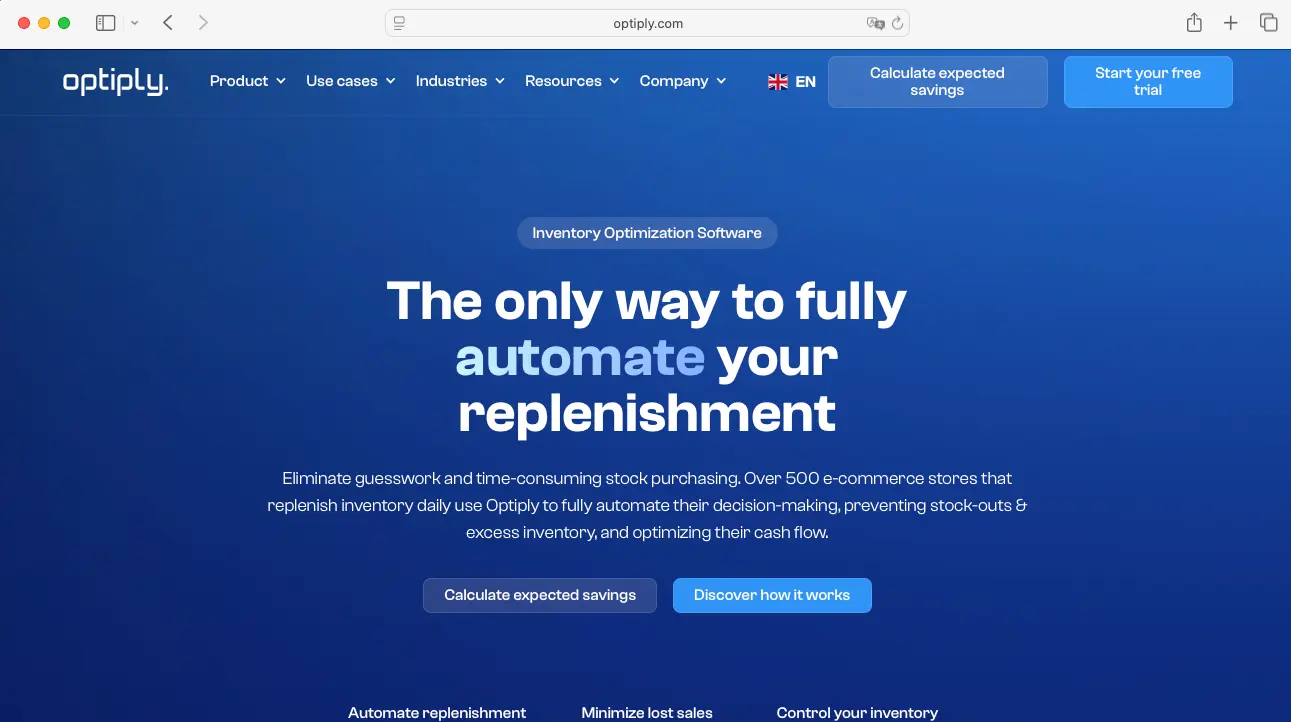
Best for: E-commerce, retail and wholesale companies that want to automate daily purchasing
What users appreciate most: Purchasing teams are able to fully automate replenishment, save at least 80% of their time on purchasing, and deal with fewer stock-outs and less excess inventory. Optiply’s fast onboarding, helpful support, and ability to scale effortlessly with growing assortments or new warehouses are also frequently mentioned.
Key features:
- Dynamic purchasing calendar to adjust to shifts in demand or supply and ensure the most profitable purchasing decision.
- Real-time forecasting to predict demand using machine learning and millions of product data points.
- ABC-XYZ categorisation and automation to organise products by revenue, margin, or sales and optimise availability.
- Multi-supplier matching to automatically select the best supplier based on price, delivery time, and availability.
- Purchase order automation to send purchasing recommendations directly to suppliers via EDI, portal, or email.
Integration with your data sources to connect ERP, WMS, pricing, marketing, and supplier data for smarter decisions.
Tygo Bril, Buyer and Process Improvement Specialist at Travel bags:
"Optiply clearly shows which brands are up next, which SKUs are needed, and the quantity required for the upcoming period. The best part is that I no longer have to think about what needs to be ordered. The suggestions are so accurate that I can rely on them almost entirely."
2. Netstock
Netstock is supply and demand planning software that helps businesses improve demand forecasting, reduce excess stock, and avoid stock-outs. It integrates directly with ERP systems like NetSuite, SAP, and Microsoft Dynamics, offering easy access to key inventory metrics.
The platform provides forecasting dashboards, intelligent replenishment recommendations, and supplier performance tracking, all designed to support more accurate, data-informed purchasing.
Netstock works best in ERP-led setups. Without a dedicated supply chain team, it may be harder to get the full value from the platform
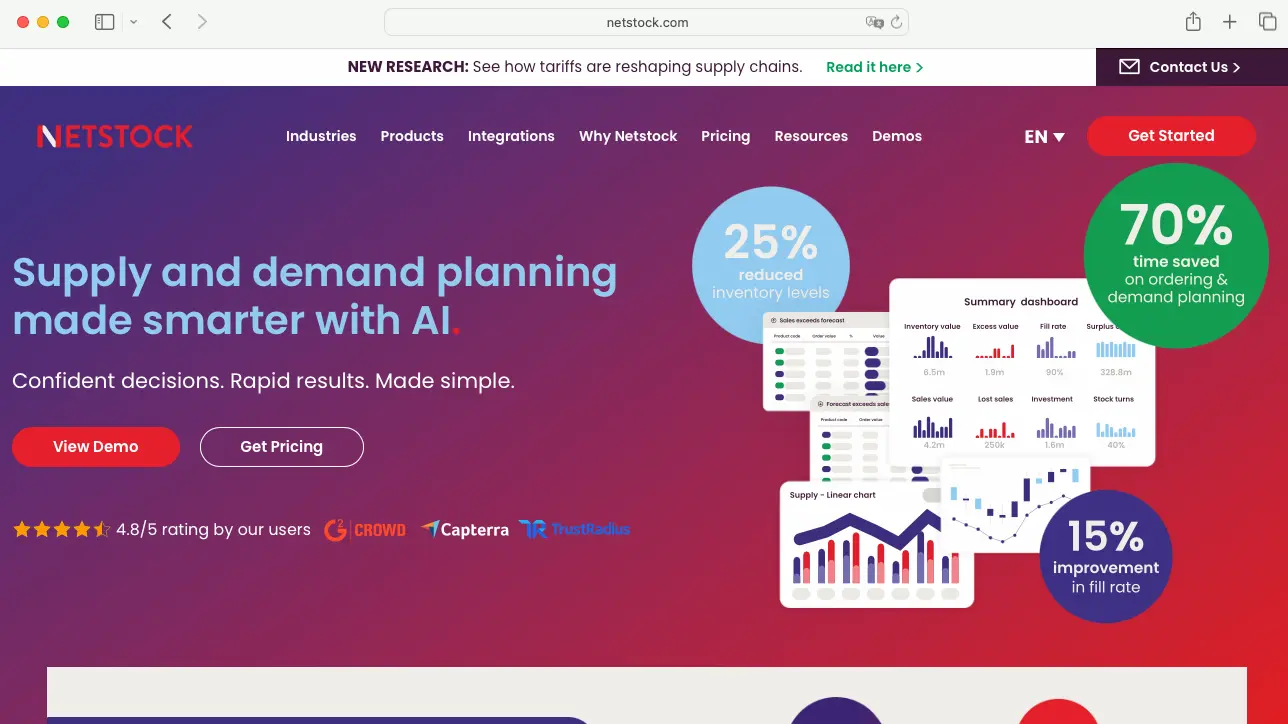
Best for: Mid-sized businesses with a strong ERP setup that want to improve planning but still prefer human decision-making in purchasing.
What users appreciate most: Users are especially positive about clear stock health dashboards, easy-to-use forecasting tools and improved demand planning and supplier management.
Key features:
- Demand forecasting based on historical data
- Inventory classification and prioritisation
- Supplier performance tracking
- Recommended reorder quantities and dates
- Strong integrations with ERPs
3. Inventory Planner by Sage
Inventory Planner is an inventory planner tool developed for e-commerce businesses and multichannel retailers. It helps users predict sales trends, plan replenishment, and avoid stock-outs or overstocking by providing accurate data on when and how much to reorder.
Since being acquired by Sage, it’s increasingly integrated into a broader finance and operations ecosystem. For e-commerce teams it’s a great tool for getting started, but it might slow you down once your assortment or order volume scales.
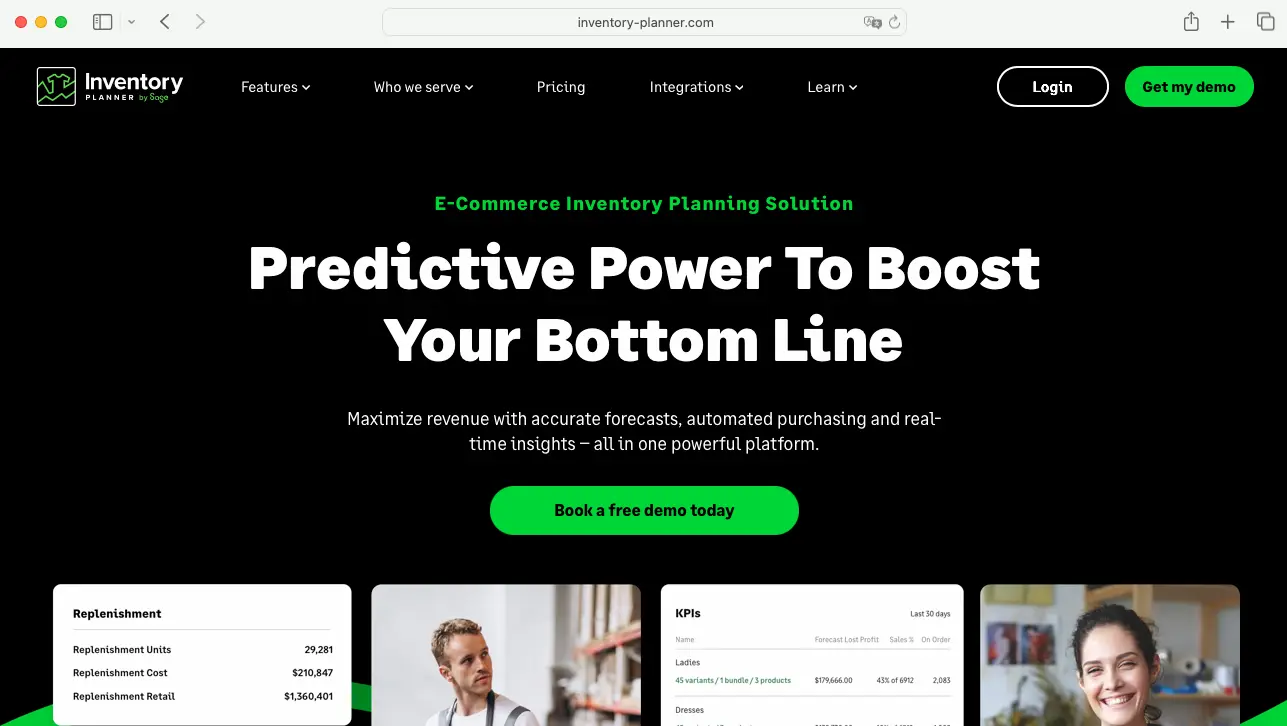
Best for: Small and growing retailers, e-commerce brands, wholesalers and manufacturing merchants that want to make purchasing decisions based on reliable customer demand predictions.
What users appreciate most: Users are especially positive about the intuitive interface, accurate SKU-level forecasting, and the ability to streamline replenishment across multiple sales channels.
Key features:
- Forecasting based on historical sales trends
- Replenishment and purchase order suggestions
- Multi-channel sales data consolidation
- Bundling and kit forecasting
- Seasonal demand adjustments
- Integration with major e-commerce platforms
4. EazyStock
EazyStock is an inventory optimisation platform that works alongside existing ERP systems to help companies improve demand forecasting, reduce excess inventory, and increase availability. With a strong focus on automation and inventory health, EazyStock is designed to support businesses aiming to improve service levels while keeping inventory costs under control.
While powerful, EazyStock is built for ERP-heavy teams. For more dynamic or fast-paced environments, it can feel rigid and overengineered.
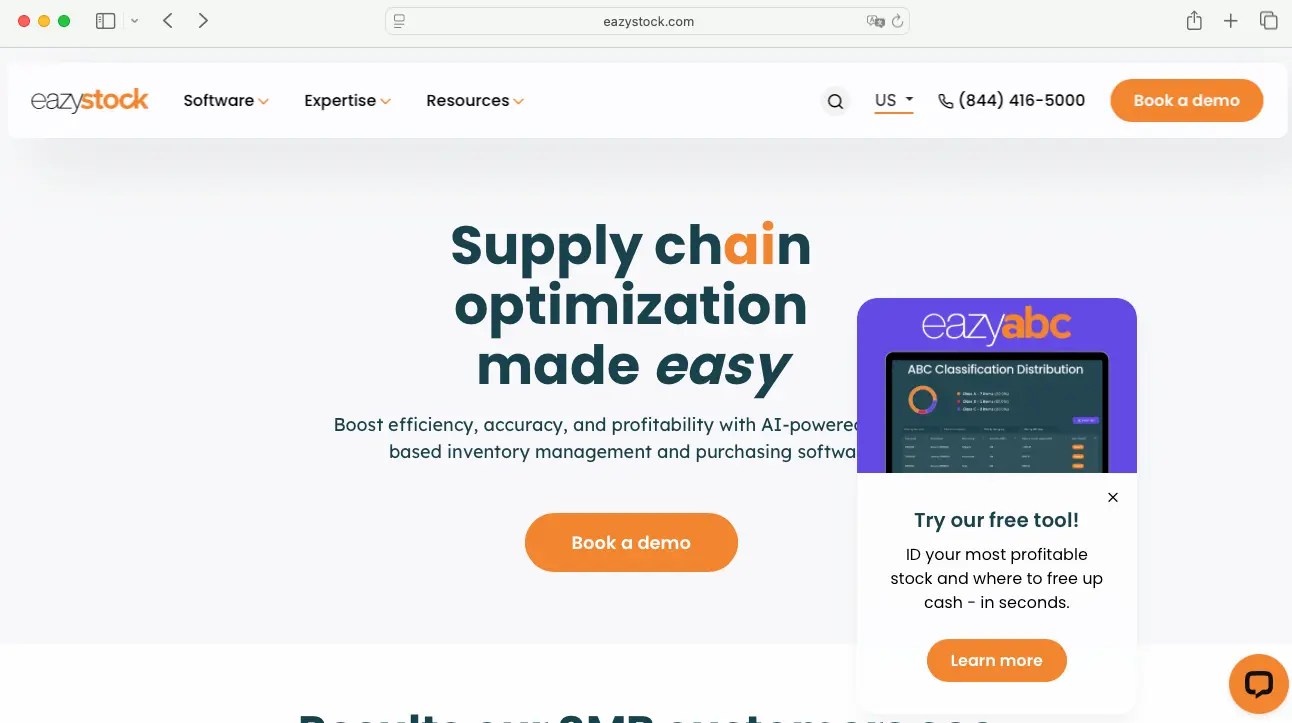
Best for: Mid-sized manufacturers, wholesalers, and spare parts suppliers looking for advanced inventory optimisation capabilities without replacing their current ERP.
What users appreciate most: Users are especially positive about the powerful forecasting engine, automated replenishment suggestions, and the way it helps reduce excess stock while improving product availability.
Key features:
- Automated demand forecasting
- Dynamic safety stock and reorder point calculations
- Inventory classification and segmentation
- Purchase order automation
- Supplier lead time tracking
- ERP integrations (e.g., Microsoft Dynamics, NetSuite)
5. Prediko
Prediko is an inventory planning and forecasting tool built for modern DTC brands using Shopify. It helps e-commerce teams manage stock levels, prevent stock-outs, and align inventory with marketing campaigns and product launches, all from a clean dashboard.
Unlike traditional inventory tools that are built for ops-heavy teams, Prediko focuses on speed, ease of use, and Shopify-native integration. It gives brands a real-time view of inventory health and helps turn sales and marketing plans into actionable purchasing timelines.
Prediko is great for early-stage brands on Shopify, but if you grow beyond that, its simplicity may start to hold you back.
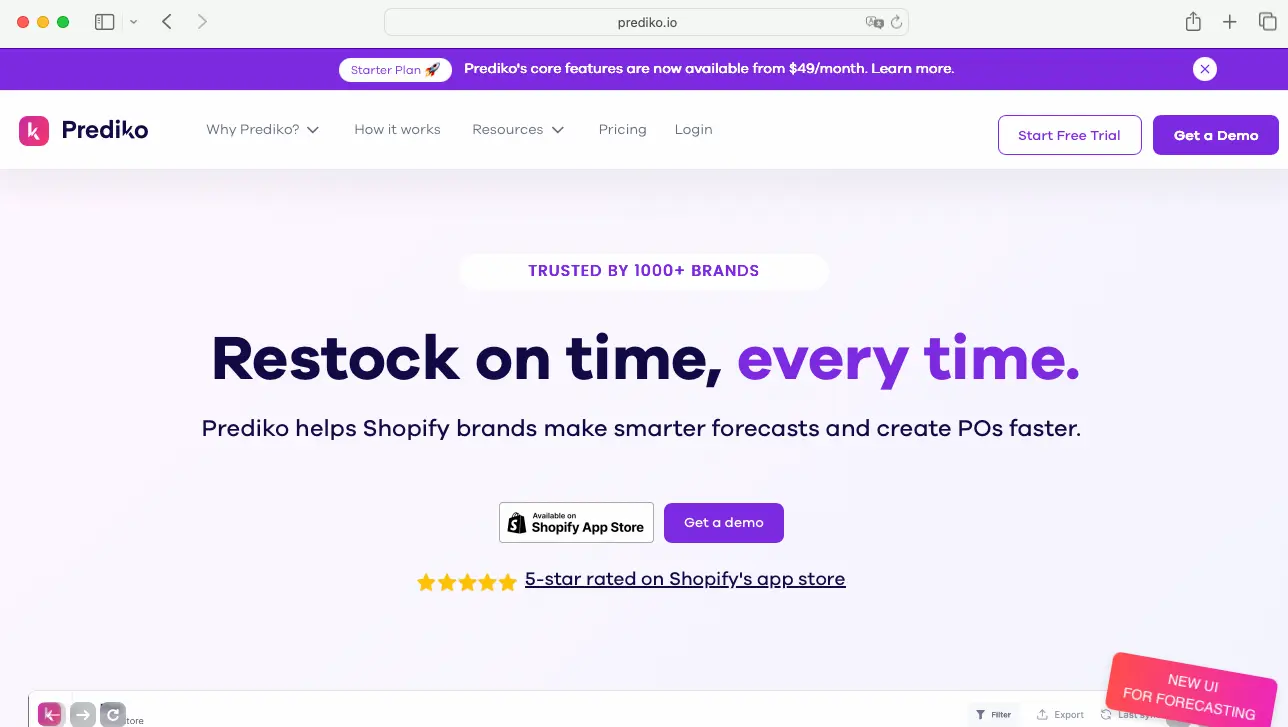
Best for: DTC brands on Shopify looking for a fast way to improve inventory visibility and align purchasing with marketing campaigns.
What users appreciate most: Users are happy with the interface, easy integration for Shopify, and the way Prediko connects sales and marketing insights to inventory decisions.
Key features:
- Demand forecasting based on sales velocity and lead times
- Purchasing plans tailored to sales goals and marketing campaigns
- Centralise purchase order management
- Slack alerts for stock-outs, replenishments, and lead time delays
- Real-time inventory health dashboard
- Shopify-native integration
How to choose the best inventory optimisation software for your business
Now that you know which solutions are worth considering, the question remains: what’s the best tool for you and your team? Unfortunately, there’s no one-size-fits-all answer when it comes to inventory optimisation. The right choice depends on your team’s setup, how often you buy, and how complex your tech stack is.
But to make the decision a little easier, here are five key factors to consider:
- Automation vs. control: Do you want your purchasing process to run largely on autopilot, or do you prefer to stay hands-on? If your team spends too much time on manual reordering and exception handling, a fully automated solution like Optiply can free up hours every day. But if your business requires deep customisation or manual control, a more traditional system might be a better fit.
- Buying frequency: Businesses that purchase daily or multiple times per week benefit most from automation. In those cases, even small inefficiencies quickly add up. If you buy weekly or monthly, and your assortment is more stable, a planning-focused tool may be enough.
- Speed of implementation: Some tools require long onboarding periods, consulting, and training sessions. Others can be live in a matter of weeks. If you’re looking to realise value quickly, without a lengthy IT project, prioritise a solution that requires minimal setup. KoopjesDrogisterij, for instance, was live within 1 to 2 weeks thanks to integrations with Exact Online and their EDI.
- Integration with your tech stack: Inventory decisions don’t happen in a vacuum. Make sure the software connects seamlessly to your ERP, WMS, supplier portals, and even pricing or marketing tools. The more complete your data, the smarter your purchasing strategy becomes.
- Scalability: Choose a platform that grows with you. Can it handle expanding assortments, new warehouses, or additional suppliers without becoming more complex to manage? Scalable automation gives you long-term flexibility without extra overhead.
It’s smart to shortlist 1–3 platforms that seem like a good fit and request a demo for each of those. Most demos take 30 minutes or less, which is much faster than recovering from the wrong decision.
Always make the right purchasing decisions, 100% automatically
Frequently asked questions about inventory optimisation software
Not sure whether you need inventory optimisation software? We’ve gathered the FAQs we hear most often from people in the field. The answers will help you make the right decision.
What’s the difference between inventory optimisation and inventory management software?
Inventory optimisation is typically a layer on top of inventory management, taking data from management systems and using it to drive smarter, more profitable inventory decisions. Inventory management software helps businesses keep track of what inventory they have, where it is, and when to reorder, often using simple rules and thresholds.
Inventory optimisation software is more advanced and uses sophisticated algorithms, real-time data and predictive analytics to optimise inventory levels. The optimisation focuses on balancing customer demand with cost efficiency, and often automates making purchasing decisions.
How much does inventory optimisation software cost?
The cost of inventory optimisation software typically ranges from €500 to €3,000+ per month, depending on your business size, assortment complexity, and feature needs. Some vendors offer modular pricing, charging based on order volume, number of SKUs, or connected systems.
Others work with annual contracts and onboarding fees. When comparing options, take into account it’s not just about the software cost. Consider how much time it saves your team, how much inventory you can free up, and how it helps avoid costly stock-outs or overstock.
Pricing is often just a fraction of the cost of stock-outs or excess inventory.
Can these tools reduce stock-outs and overstock?
Yes, inventory optimisation can significantly reduce both.
Stock-outs
Inventory optimisation software uses advanced analytics, real-time data, and predictive modeling to forecast demand and identify key drivers of stock-out, such as long lead times or unexpected demand spikes.
By proactively adjusting reorder points and safety stock levels, the software ensures that inventory is replenished before shortages occur, minimising the risk of running out of stock and helping maintain customer satisfaction.
Overstock
The same predictive and optimisation capabilities help prevent overstock by accurately forecasting demand and aligning inventory levels with actual consumption patterns. By analysing historical sales, market trends, and supply chain variability, the software recommends optimal order quantities and timing, reducing excess inventory and associated holding costs.
What makes this possible? Real-time insight into your inventory, smart reorder suggestions, optimised safety stock, and scenario planning to prepare for supply and demand changes.
Why Optiply is your best choice to automate replenishment and optimise your cash flow
Across thousands of conversations with buyers, one question keeps coming back: what should I order, when, and how much? At Optiply, we believe purchasing shouldn’t be this complex. That’s why we built an AI-driven platform that automates inventory management and helps companies around the world build autonomous, sustainable supply chains.
The idea for Optiply started during our studies, where we experienced first-hand how difficult replenishment becomes without the right insights. Especially when expensive stock is involved, relying on gut feeling isn’t just risky, it’s costly. Manual purchasing wastes time, ties up cash, and exposes businesses to unnecessary errors.
That’s why, today, over 500 e-commerce, wholesale, and retail companies fully automate their purchasing with Optiply. And we’re proud of the results we achieve together. They spend up to 80% less time on procurement, avoid 80% of stock-outs, reduce excess inventory by up to 30%, and increase turnover with the same or even less stock.
Sounds great, right? It sounds even better when our customers talk about the collaboration. Check out our customer stories, or calculate the expected savings for yourself.
Need a little more information or help? Book a free demo, we’ll explain how the platform works and give you advice on growing your online store, wholesale, or retail operation with less inventory.
Answers to frequently asked questions
Do you have questions about Optiply? We've gathered the most frequently asked questions for you.












.webp)
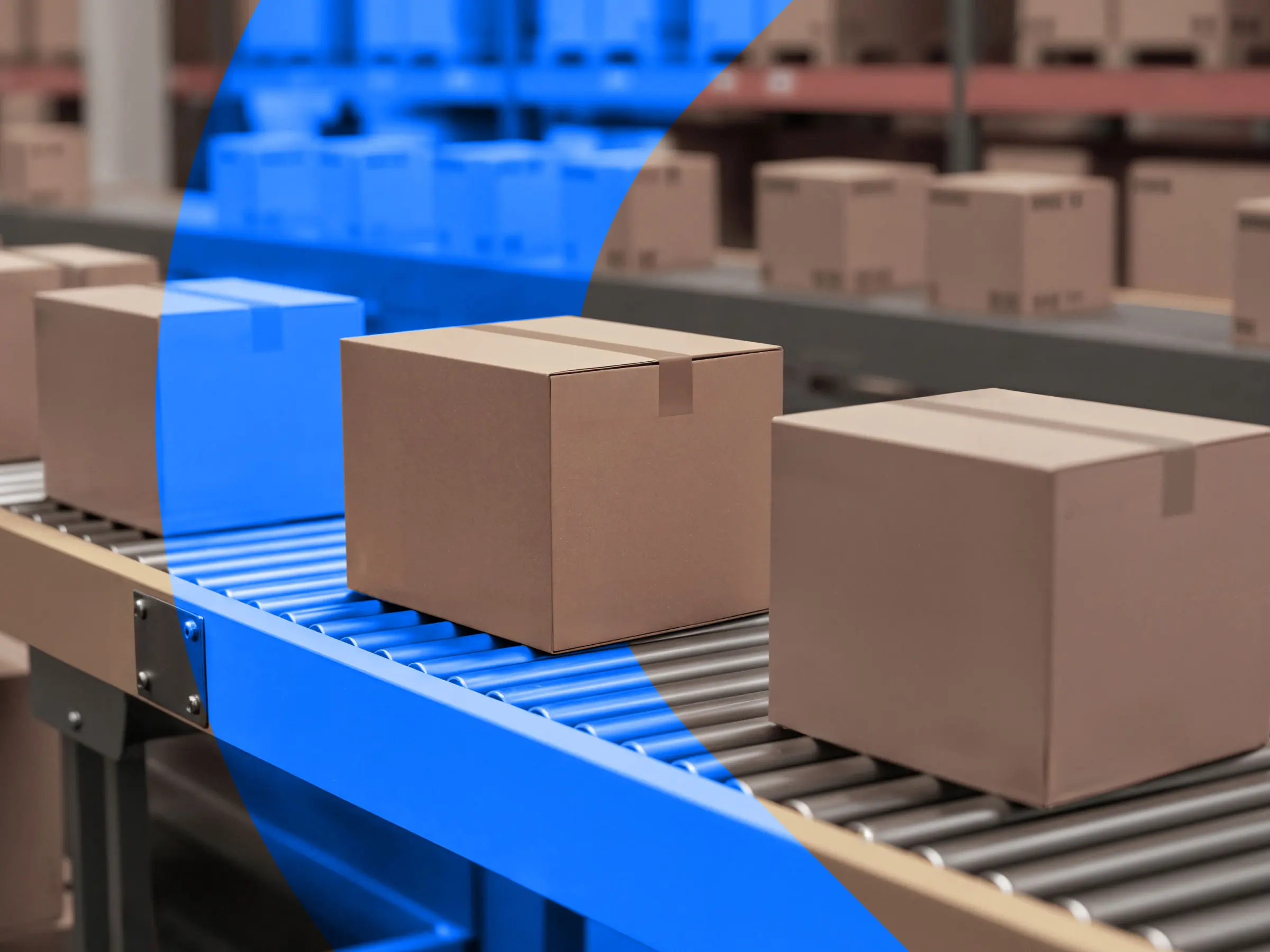
.webp)